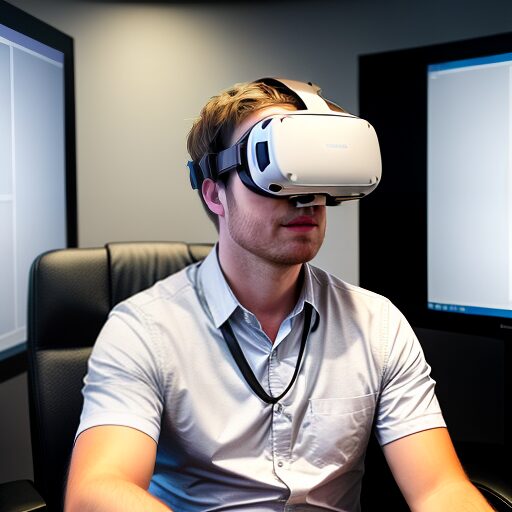Harnessing VR for Accident Prevention
Are you curious about how Virtual Reality (VR) can revolutionize safety measures and accident prevention in various industries? Many companies, are pioneering the use of VR technology as a powerful tool to proactively mitigate risks and ensure workplace safety.
Understanding the Potential of VR
Virtual Reality offers a simulated environment that allows users to experience and interact with realistic scenarios without real-world consequences. By immersing individuals in lifelike simulations, VR enables them to practice safety protocols, identify potential hazards, and develop critical decision-making skills in a controlled setting.
VR: A Tool for Preventative Measures
In the realm of accident prevention, VR serves as a proactive solution to anticipate and address safety concerns before they escalate into incidents. By simulating hazardous scenarios, such as industrial accidents or workplace emergencies, VR enables workers to familiarize themselves with safety procedures, equipment operation, and emergency protocols in a risk-free environment.
Advantages of VR-Based Training
Utilizing VR for safety training offers several advantages over traditional methods. VR-based simulations provide realistic and engaging experiences that enhance learning retention and knowledge transfer. Additionally, VR allows for scalable and repeatable training sessions, enabling organizations to efficiently train large numbers of employees while minimizing downtime and logistical challenges.
Real-World Applications
From manufacturing plants to construction sites, VR is being integrated into various industries to improve safety practices and reduce the likelihood of accidents. By immersing workers in virtual environments, organizations can identify and address potential hazards, reinforce safety protocols, and empower employees to respond effectively to unforeseen situations.
Collaborative Efforts for Safety Innovation
Companies collaborates with industry partners and safety organizations to develop tailored VR solutions that address specific safety challenges across different sectors. By leveraging our expertise in VR technology and safety management, we’re committed to creating safer work environments and preventing accidents through innovative virtual training programs and simulations.
Looking Towards the Future
As technology continues to evolve, VR will play an increasingly vital role in shaping the future of safety training and accident prevention. By embracing VR as a proactive tool for risk mitigation, organizations can enhance workplace safety, protect employees, and ultimately save lives. Start-ups are dedicated to advancing the use of VR to foster a culture of safety and empower individuals to make informed decisions in high-risk environments.
Advancing Safety Culture with VR
The integration of VR technology into safety practices represents a significant step forward in cultivating a robust safety culture within organizations. By incorporating VR-based training and simulations into regular safety protocols, companies can instill a heightened sense of awareness and preparedness among employees.
Empowering Workers Through Immersive Experiences
VR empowers workers to immerse themselves in realistic scenarios and actively participate in safety drills and simulations. By placing individuals in challenging situations within a virtual environment, VR fosters experiential learning and equips workers with the skills and confidence needed to navigate hazardous conditions effectively.
Tailoring Solutions to Industry Needs
New businesses understand that each industry faces unique safety challenges and requirements. That’s why we collaborate closely with our clients to develop customized VR solutions that address specific safety concerns and operational needs. Whether it’s training for confined space entry, hazardous material handling, or emergency response procedures, our VR simulations are tailored to meet the demands of diverse industries.
Driving Continuous Improvement
The implementation of VR for accident prevention goes beyond mere compliance with safety regulations—it fosters a culture of continuous improvement and innovation. By regularly engaging employees in VR-based safety training and scenario-based exercises, organizations can identify areas for improvement, refine safety protocols, and proactively mitigate risks before they escalate.
Leveraging Data for Insights and Analysis
One of the key advantages of VR technology is its ability to capture data and provide valuable insights into user behavior and decision-making processes. By analyzing user interactions within VR simulations, organizations can identify common safety lapses, areas of uncertainty, and potential bottlenecks in emergency response protocols. This data-driven approach enables companies to fine-tune their training programs and optimize safety procedures for maximum effectiveness.
Embracing a Future of Safer Workplaces
As VR technology continues to evolve and become more accessible, the potential for enhancing safety practices and preventing accidents is limitless. By embracing VR as a proactive tool for safety training and risk management, organizations can create safer workplaces, protect their most valuable asset—their employees—and pave the way for a future where accidents are a thing of the past.
Conclusion
In conclusion, VR represents a transformative force in the realm of accident prevention, offering immersive experiences that empower workers, drive continuous improvement, and shape a safer future for all. Startups are committed to leveraging the power of VR to revolutionize safety practices and foster a culture of proactive risk management in organizations worldwide. Together, let’s embrace the potential of VR to create safer, more secure workplaces for generations to come.

